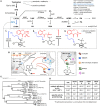The Synthesis of Kynurenic Acid in Mammals: An Updated Kynurenine Aminotransferase Structural KATalogue
- PMID: 30873412
- PMCID: PMC6400995
- DOI: 10.3389/fmolb.2019.00007
The Synthesis of Kynurenic Acid in Mammals: An Updated Kynurenine Aminotransferase Structural KATalogue
Abstract
Kynurenic acid (KYNA) is a bioactive compound that is produced along the kynurenine pathway (KP) during tryptophan degradation. In a few decades, KYNA shifted from being regarded a poorly characterized by-product of the KP to being considered a main player in many aspects of mammalian physiology, including the control of glutamatergic and cholinergic synaptic transmission, and the coordination of immunomodulation. The renewed attention being paid to the study of KYNA homeostasis is justified by the discovery of selective and potent inhibitors of kynurenine aminotransferase II, which is considered the main enzyme responsible for KYNA synthesis in the mammalian brain. Since abnormally high KYNA levels in the central nervous system have been associated with schizophrenia and cognitive impairment, these inhibitors promise the development of novel anti-psychotic and pro-cognitive drugs. Here, we summarize the currently available structural information on human and rodent kynurenine aminotransferases (KATs) as the result of global efforts aimed at describing the full complement of mammalian isozymes. These studies highlight peculiar features of KATs that can be exploited for the development of isozyme-specific inhibitors. Together with the optimization of biochemical assays to measure individual KAT activities in complex samples, this wealth of knowledge will continue to foster the identification and rational design of brain penetrant small molecules to attenuate KYNA synthesis, i.e., molecules capable of lowering KYNA levels without exposing the brain to the harmful withdrawal of KYNA-dependent neuroprotective actions.
Keywords: PLP enzyme; crystal structure; kynurenic acid; kynurenine aminotransferase; kynurenine pathway.
Figures


Similar articles
-
Kynurenine Aminotransferase Isozyme Inhibitors: A Review.Int J Mol Sci. 2016 Jun 15;17(6):946. doi: 10.3390/ijms17060946. Int J Mol Sci. 2016. PMID: 27314340 Free PMC article. Review.
-
Kynurenic Acid Levels and Kynurenine Aminotransferase I, II and III Activities in Ganglia, Heart and Liver of Snail Helix Pomatia.Cell Physiol Biochem. 2023 Aug 18;57(4):279-297. doi: 10.33594/000000643. Cell Physiol Biochem. 2023. PMID: 37597169
-
Assessment of Prenatal Kynurenine Metabolism Using Tissue Slices: Focus on the Neosynthesis of Kynurenic Acid in Mice.Dev Neurosci. 2019;41(1-2):102-111. doi: 10.1159/000499736. Epub 2019 May 22. Dev Neurosci. 2019. PMID: 31117076 Free PMC article.
-
Galantamine-Memantine Combination and Kynurenine Pathway Enzyme Inhibitors in the Treatment of Neuropsychiatric Disorders.Complex Psychiatry. 2021 Aug;7(1-2):19-33. doi: 10.1159/000515066. Epub 2021 Feb 8. Complex Psychiatry. 2021. PMID: 35141700 Free PMC article. Review.
-
Angiotensin-converting enzyme inhibitors modulate kynurenic acid production in rat brain cortex in vitro.Eur J Pharmacol. 2016 Oct 15;789:308-312. doi: 10.1016/j.ejphar.2016.07.023. Epub 2016 Jul 14. Eur J Pharmacol. 2016. PMID: 27423316
Cited by
-
Kynurenine Metabolism and Alzheimer's Disease: The Potential Targets and Approaches.Neurochem Res. 2022 Jun;47(6):1459-1476. doi: 10.1007/s11064-022-03546-8. Epub 2022 Feb 8. Neurochem Res. 2022. PMID: 35133568 Review.
-
Kynurenine Pathway Modulation by Exercise in Multiple Sclerosis: Implications for Neuroprotection and Inflammation.Cell Mol Neurobiol. 2025 Jul 22;45(1):74. doi: 10.1007/s10571-025-01596-4. Cell Mol Neurobiol. 2025. PMID: 40694215 Free PMC article. Review.
-
IDO and Kynurenine Metabolites in Peripheral and CNS Disorders.Front Immunol. 2020 Mar 5;11:388. doi: 10.3389/fimmu.2020.00388. eCollection 2020. Front Immunol. 2020. PMID: 32194572 Free PMC article. Review.
-
Kynurenine Pathway of Tryptophan Metabolism in Neuropsychiatric Disorders: Pathophysiologic and Therapeutic Considerations.Clin Psychopharmacol Neurosci. 2020 Nov 30;18(4):507-526. doi: 10.9758/cpn.2020.18.4.507. Clin Psychopharmacol Neurosci. 2020. PMID: 33124585 Free PMC article. Review.
-
Relationships of Ischemic Stroke Occurrence and Outcome with Gene Variants Encoding Enzymes of Tryptophan Metabolism.Biomedicines. 2021 Oct 11;9(10):1441. doi: 10.3390/biomedicines9101441. Biomedicines. 2021. PMID: 34680558 Free PMC article.
References
-
- Alkondon M., Pereira E. F., Yu P., Arruda E. Z., Almeida L. E., Guidetti P., et al. . (2004). Targeted deletion of the kynurenine aminotransferase ii gene reveals a critical role of endogenous kynurenic acid in the regulation of synaptic transmission via alpha7 nicotinic receptors in the hippocampus. J. Neurosci. 24, 4635–4648. 10.1523/JNEUROSCI.5631-03.2004 - DOI - PMC - PubMed
-
- Bellocchi D., Macchiarulo A., Carotti A., Pellicciari R. (2009). Quantum mechanics/molecular mechanics (QM/MM) modeling of the irreversible transamination of L-kynurenine to kynurenic acid: the round dance of kynurenine aminotransferase II. Biochim. Biophys. Acta 1794, 1802–1812. 10.1016/j.bbapap.2009.08.016 - DOI - PubMed
-
- Billker O., Lindo V., Panico M., Etienne A. E., Paxton T., Dell A., et al. . (1998). Identification of xanthurenic acid as the putative inducer of malaria development in the mosquito. Nature 392, 289–292. - PubMed
Publication types
LinkOut - more resources
Full Text Sources
Research Materials

